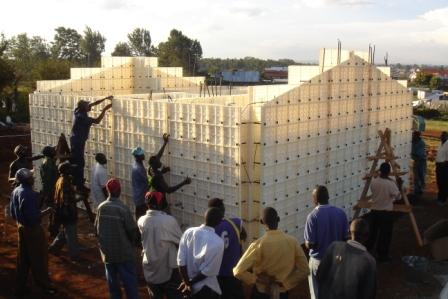-
Home
-
Speed
wall
-
construction speed
-
Mass
wall construction
-
wall building system
|
- Introduction
 - Speed wall | speed wall construction | mass wall construction
- Speed wall | speed wall construction | mass wall construction
In order to be competitive in low cost
mass housing developments, the key to success is the SPEED of
construction. More importantly the speed of constructing the wall
of the building.
 has been supplying its
comprehensive speed in formwork construction system, of which the has been supplying its
comprehensive speed in formwork construction system, of which the
 formwork is merely a
constituent of this technology, for the past 23 years. As a result, we
do not simply supply modular plastic formwork, but a holistic wall building
technology, that has been specifically designed and is proven too
benefit the end user with its simplicity and ease of use. formwork is merely a
constituent of this technology, for the past 23 years. As a result, we
do not simply supply modular plastic formwork, but a holistic wall building
technology, that has been specifically designed and is proven too
benefit the end user with its simplicity and ease of use.

Speed in wall construction
 has developed a
mass cast housing or wall
system to construct durable structures of quality in the shortest
possible time, as speed in wall construction is important. has developed a
mass cast housing or wall
system to construct durable structures of quality in the shortest
possible time, as speed in wall construction is important.
This system has developed into a speed wall construction technology that addresses
thirteen key challenges embodied in the speed of delivering low cost and affordable housing
shortages facing developing countries namely:
- lack of resources
- insufficient funds
- skills shortage
- time constraint
- work flow control
- time constraints
- waste
- speed of wall
construction
- speed of completion
- speed in moving from site to site
- no finishing on wall
- speed in electrifying
- speed in plumbing
Traditional bricks or
blocks are moulded in a small mould and then laboriously stacked by an
artisan, sandwiched with mortar to create a wall. The electrical and
water pipes are placed by grinding and chasing into the wall. The wall
is then plastered to cover the pipes and services, as well as the
brickwork, to create a level and smooth surface. The speed of wall
construction is dependant on skilled labour.
A few disadvantages of brick or block construction are:
- Labour intensive
- slow speed
- Compressive
capacity only
- Skilled labour
- Mortar shrinkage
- Thermal expansion
and contraction
- Leveling
- Erratic supplies =
erratic delivery
- Waste
- Rework
- Slow delivery
- Inconsistent
quality
- Unpredictable cash
flow
- Increased cost
The
 patented technology is cost effective
due to its repetitive application. It is affordable due to the fact that
the
patented technology is cost effective
due to its repetitive application. It is affordable due to the fact that
the
 formwork is used on a
repetitive basis for up to 50 reuses per kit; this results in the cost
of the formwork being amortized over the construction of 50 units. formwork is used on a
repetitive basis for up to 50 reuses per kit; this results in the cost
of the formwork being amortized over the construction of 50 units.
By combing the
 re-usable,
patented, recyclable lightweight plastic injection moulded formwork
system, with a South African Bureau of Standards approved lightweight
aerated mortar, Agrément Certificate 94/231, a full scale mould of the
designed house is configured with all the services, both plumbing and
electrical, are cast in situ as a monolithic reinforced walling system.
Chasing, beam filling, plastering and wastage are eliminated, producing
a fast track, cost effective, transferable construction technology -
speeding up mass housing construction. re-usable,
patented, recyclable lightweight plastic injection moulded formwork
system, with a South African Bureau of Standards approved lightweight
aerated mortar, Agrément Certificate 94/231, a full scale mould of the
designed house is configured with all the services, both plumbing and
electrical, are cast in situ as a monolithic reinforced walling system.
Chasing, beam filling, plastering and wastage are eliminated, producing
a fast track, cost effective, transferable construction technology -
speeding up mass housing construction.
In simple terms,
 has: has:
- A constant supply
of materials
- Known costs
- Unskilled
operators
- Next to no waste
- Increased
productivity
- Reduced cost
- Consistent quality
- Predictable cash
flow
- speed in wall construction

Key Points:
- Holistic building
technology
- Ease of use
- Monolithic
reinforced wall system
- Fast track, cost
effective, transferable construction wall technology
- Use to
Speed wall, speed, wall, speed construction,
speed wall mass construction, speed construction, mass speed wall,
speed wall construction, speed panel,
industrialized building system, wall formwork system, low cost mass
housing, wall speed
|